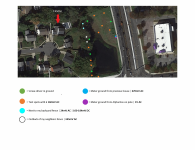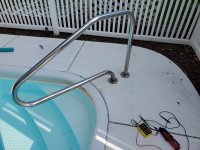As I said I am not a lineman and have not studied power distribution.
Power companies do not run neutrals in the grid. They are derived at the transformer feeding a business or house.
And as I stated and he confirms that the problem will manifest itself in circuits with neutrals. Here is another point to look at if his run to the pool is long the copper wires will act as a resistive load and you can get a voltage between the neutral and the EGC. This can be eliminated or reduce to with in code of a total of 5% for service drop and circuit length in the residence by running a bigger wire.
Yes industry can and do cause imbalance on the grid cause single phase brown outs or even total brown outs. I used to work in an area where an business was required to call the power company before turn on their equipment, because it drew such a large load that it effected the area around it.
You can track this with a chart recorder or even a volt meter with a min max function. Although you will only be watch one phase with a digital meter unless it has the ability to monitor two hots or your have two meters.
I've worked in electric power distribution engineering for decades and have a BS in electrical engineering. I've investigated stray voltage issues at dairy farms (cows are usually more sensitive than humans, and their milk production suffers in the presence of stray voltage). I'm reading thru this sequence of posts to see if there is anything I can add; however, it's a long list and I'm still only part-way thru!!
HOWEVER, I do have to chime in regarding neutrals. In North America, "distribution" systems DO RUN NEUTRALS. In the context of electric power distribution, three-phase power comes with a fourth wire. Single-phase uses two wires (services into homes are single-phase with three wires).
"The Grid" generally is used to refer to "transmission" systems that, indeed, do not include neutrals (since the bulk power system is generally large enough to remain relatively balanced and not need the neutral to carry the imbalance).
What's the difference? Think of the electric transmission system as analogous to freeways that run between cities, while distribution systems are analogous to a city's surface streets. All but VERY large industrial loads get their services from the distribution level (generally 15kV to 40kV class, 3 phase, compared to 69kV - 765kV for subtransmission and transmission).
I hope I read this in the posts I haven't gotten to yet, but it bears repeating ... DO NOT EVER "LIFT THE NEUTRAL" WHEN YOUR SERVICE IS ENERGIZED (or will be unexpectedly, as in during an outage). You are almost guaranteed to damage equipment at a minimum when the power is on or restored. Note that utilities will de-energize your service for you to work on your systems, most (but not all) without charge to you.
On a single-phase 120/240V service to a residence, the neutral defines the "midpoint" of the 240V supply and provides the two 120V "legs". Without the neutral reference, imbalance between the load on the 120V legs will make one leg rise and the other leg fall in voltage. Either option damages equipment (motors try to compensate low voltage by drawing more current and overheating, while electronics can be fried and resistive loads overheat with high voltage).
I need to take a break in reading the remaining posts before I can come back to check if there's anything else for me to add. I just don't want anyone else reading through this thread to be pulling the prior comments of "lifting the neutral" out of context and creating hazards for themselves!





